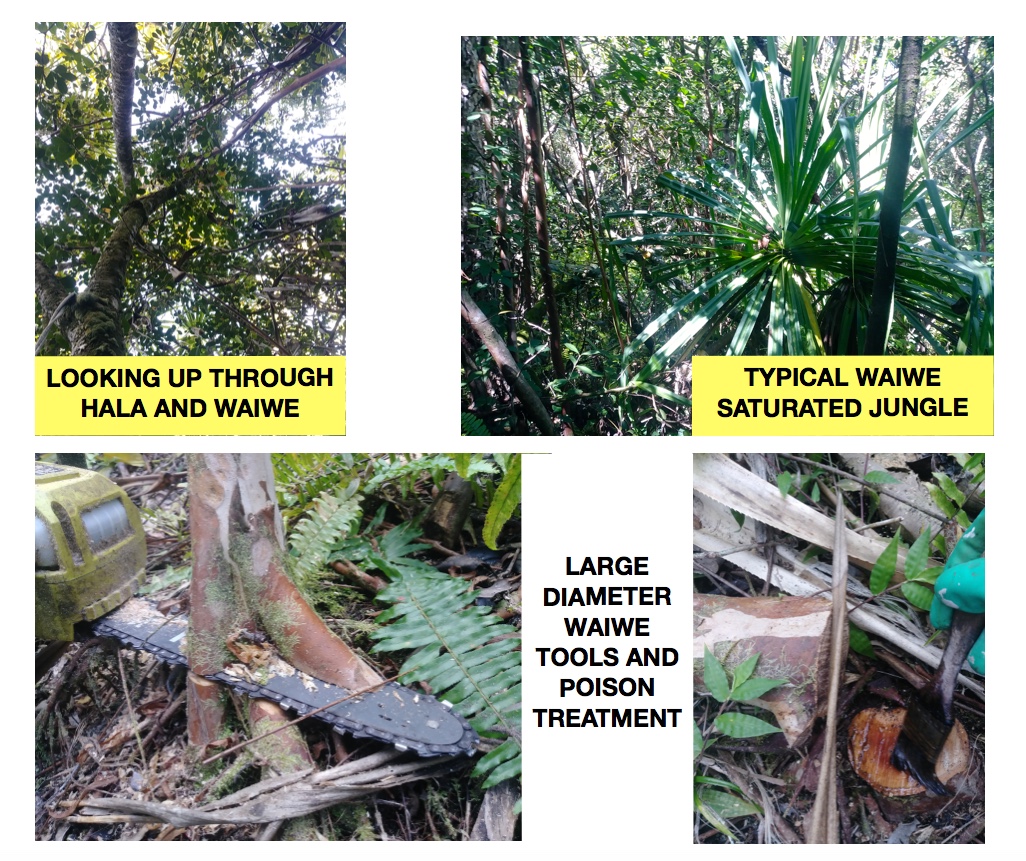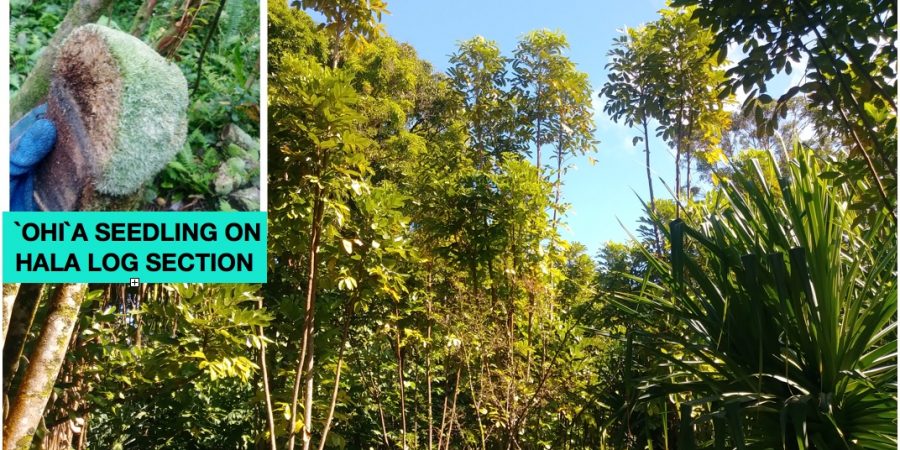HALEPUA`A FOREST WORK REPORT
MALAMA O PUNA ANNUAL GENERAL MEETING 8/8/2020
TRANSCRIPT: Ok, before I dive into the report, I’d like to give you just a little background on myself. I have loved nature my whole life, and although lacking any formal life sciences education, have been consistently involved in healthy horticultural practices since 1991. My background includes organic farming apprenticeships, Korean natural farming certification, and small-scale organic farming and permaculture in Puna. I am Board President of Dragon’s Eye Learning Center 501c(3) which I co-founded in 2004 to “provide educational experiences of cooperative and sustainable agricultural and economic systems.” Although currently in hibernation, this organization has important connections that could prove useful in partnership with MOP on projects of mutual interest.

The current grant work focuses on a roughly 35 acre slice of the Halepua`a section of the Nanawale Forest Reserve adjacent to Papaya Farms Rd. and Railroad Ave.

The area is being developed as a native tree sanctuary corridor, through control of nonnatives, maintenance of a Connector Trail joining local commuities, and systematic planting of endemic and indigenous species. The original main criterium for selecting this area was its convenient proximity to Malama O Puna’s native plants nursery located at Hale He`e and to the homes of volunteer workers, principally Ann Kobsa. The arrival of little fire ants to Hawai`i brought a serious additional reason: because this section of forest shares borders with multiple occupied private properties, it is the most vulnerable to little fire ant infestation.

In the roughly 18 months I’ve done this grant work, fully 40% of grant labor funds have gone to manage, maintain, re-establish, test, and treat 3/4 of a mile of little fire ant barrier on two fronts. This work involves felling and poisoning of nonnative tree species through which the ants can bridge into the forest, principally waiwe, cecropia, and melochia. The shrub clydemia needs periodic handling to make the trails traversible. A specific story illustrates the challenges. Last fall during fruiting season, despite regular periodic insecticide treatment, a large wave of LFA made it across the barrier through the waiwe trees. That incursion required 19 hrs. of labor to test and treat several thousand square feet of forest.

This year, to prevent the same scenario, 7 hrs of paid work and 20 hours of donated labor from Ann’s work-traders were put to felling waiwe over 400 feet of trail before they fruited. On a positive note, the Bifenthrin applied every 6 weeks is an effective deterrent, and with training and experience I’ve refined the techniques to really maximize budgetary efficiency. It is important to note that Bifenthrin may not always be available to us, and that insecticides are toxic chemicals dangerous to both human and environmental health. It seems obvious that our islands need to adopt a large-scale, comprehensive little fire ant bio-control program to provide sustaining protection from this plague. Currently unaddressed are at least two other spots in this almost 700 acre Reserve tract that contain already-detected LFA incursions. These are more remote parts of the forest, requiring long walks with full sprayers to manage, measures beyond the scope of the current work.

I wish I had a photograph to show you, but from the top of a coconut tree, I am able to look out over much of this section of forest and see a sea of hala trees, interspersed with the spires of both vibrant and ROD-deadened `oh`ia. Unfortunately, working from ground level within the forest, we are confronted with the pervasive presence of strawberry guava, or waiwe. 28% of grant labor funds have gone to controlling nonnative trees, shrubs, and vines, waiwe being the most prominent. The trees can be killed by gash treatment of herbicide, or by felling and treating the stumps. Otherwise, the trees re-grow. That being said, the taller native trees are able to tolerate some amount of co-existence with the lower waiwe, whose thick shade does provide the benefit of suppressing difficult-to-manage nonnative ground-cover and understory weeds.

Waiwe cutting and treatment occurs predominantly in areas determined to be good plots for planting. These are places in which sparser amounts of hala and `ohi`a provide from 25% to 65% shade. The waiwe is removed using chainsaw, hand saw, and loppers, and the stumps poisoned. The dead organic matter has been variously shaped into pig-deterrent fences, mulched onto existing and newly-planted native trees, or piled to decompose.
For other nonnative species, we do see quite a bit of melochia and cecropia. I have been steadily working at poisoning the large trees along the trails—and especially along the LFA barrier trails—where they stand, using three different herbicides. This work is ongoing and I’m slowly extending the reach of this kill-zone. Again, with using these poisons it is important to note the likelihood of unintended harm to the biodiversity of the soil food web, even when used with precision. Also worth mentioning are the negative health effects upon the applier, through inevitable inadvertent contact. I am constantly looking for ways, whether through timely succession plantings, the assuming of additional maintenance, or special tools, to reduce poison usage in my efforts to save the forest.
One tool I’ve discovered is the weed wrench. For small to medium waiwe up to one inch, and for all clidemia, this powerful and simple steel clamp/pry bar set has circumvented countless herbicide treatments. I need only be careful to not use it near `ohi`a trees to avoid damaging the roots.
At ground level, maile pilau must be pulled out by hand, as must numerous seedlings of primarily melochia. Where albizia appears, I am scrupulous to get every last seedling. Vignahosii is the final pest worth mentioning. This wispy vine, which roots at the node, is almost impossible to manually remove, and during the summer can clamber onto plantings within a month. Currently, other than herbicide, the only approach I’ve developed is to gradually replace it with a native ground cover, kamanamana.

Kamanamana is a robustly healthy endemic ground-cover that can grow well in sun or shade, and that has decent hardiness against aggressive competitors. It seeds prolifically over a period of many months. The sticky seeds get picked up by birds, pigs, and forest workers, to be spread throughout the area. I have been enhancing these efforts by establishing a kamanamana nursery at Hale He`e and for the last six months planting one kamanamana with each tree. Additionally, I have established three experimental kamanamana ground-cover plots at which there was no pre-existing nonnative ground cover, and have planted kamanamana along pig trails in hopes of making use of this vector. Finally, I am working on techniques for spreading kamanamana seed directly, rather than the costly effort of nursery starts.

The corridor contains roughly eight plots, six of which I’ve established, while two have been reclaimed from previous work. Each tree is planted with sun and drainage considerations in mind, and is protected variously from pig damage.

The most common technique is cage sticks, which are lengths of sharpened guava sledged into the ground around the sapling as a deterrent. Less often, I’ve woven long, thin guava circularly through these cage sticks to further solidify the protection. Finally, I established one large plot in which the waiwe was all used to erect a 3-4’ tall hedge-like barrier around the whole plot. In the 18 months I’ve been doing this work, I’ve been blessed to encounter very little pig damage to my work, but this contrasts with others’ experience in the past. Only time will tell whether and to what extent these protections are effective. Each plant is watered in with fertilizer, and plants are visited periodically for weeding. Also, previous and new plantings are established and maintained along the trails, together with red ti trail marker plantings.

In terms of species, the most successful seem to be `ohe, loulu, akia, and `ohi`a. Mamaki, kolea and kopiko are uncommonly vulnerable to the twig borer, despite fungal insecticide treatments. In accordance with Ann’s nursery work, my most recent plantings have been almost entirely the fast-growing `ohe and kamanamana, as these species currently provide the best hope of claiming both canopy and terrestrial space with communities of native species. On average, 23% of grant labor funds go directly to planting, each tree costing MOP $12 to get into the ground. In addition, 9% of labor funds have gone to office and administration, including record-keeping, report composing, demonstration assembly, and most recently videographic archiving of the forestry work. These archives stand ready to be organized into a short informational video about the ongoing work here.

This forest work wouldn’t be possible without in-kind donations from Ann Kobsa and the Hale He`e nursery. To date, $8625 in real MOP dollars has been allocated to my forest work. During the same period, $7730 in value has been chipped in, comprised of 293 hrs. of labor, $2144 towards 293 trees and 251 nursery ground-covers, and $95 towards pesticides. I want to thank Ann for her tireless, and sometimes thankless, work for the forest, and for mentoring me in this learning.
In addition to Ann, I would also like to thank Jasmine van den Heuvel for re-igniting my love of the wild natural world. The opportunity I’ve been provided through the Halepua`a grants has literally opened my eyes to the beauty and importance of the still-forested lands here in Puna. This tiny section of forest has become my kuleana, and its restoration and protection an important focus in my life. That being said, I do humbly acknowledge the gap in my formal education regarding forest restoration practices and if staying with the work, hope to gradually take on trained collaborators and/or professional development.
In terms of the future and the big picture, I think that this native tree corridor is a project worthy of continued funding. Depending on funding level, one or more additional contractors could accelerate the work. I would be willing to take part in grant writing to expand or enhance the project, and have a specific proposal to float later in the meeting. This project’s territory, accessibility, and systems are stable enough now that volunteer days could begin to be organized for large planting or weeding jobs. Over the course of several more years, it is likely that areas of significant kamanamana ground cover will have become established, and the diversity of species and sizes of native trees along the trail will be a valuable aesthetic and educational resource. Possible heavy pig damage, hurricanes, lava flows, or unexpected fast-moving diseases could hamper these outcomes.
For on-going protection of this Reserve from development, I also think that it is crucial to re-establish the locations and statuses of the certandra specimens within the forest, and to re-double our efforts at cultivating more certandra. Also, the biological, archaeological, and cultural links between this forest and the Wai`ele and Kahuwai properties should be studied, emphasized, and advocated for. I’d like to speak to this point later in the meeting. Use of the Forest by native Hawaiians for customary and traditional hunting and gathering practices should be encouraged and documented. Possibly, areas of the forest could be enhanced for gathering by emphasizing planting of canoe and even more recently introduced food and fiber trees. Protecting the entire reserve from little fire ant and pig are monumental projects far beyond the current level of funding, as is any hope of restoring the entire forest to a predominantly pre-human-contact state. This doesn’t take away from the fact that this is a beautiful resource, a native biodiversity reserve, a valuable carbon sink, and a place that should be protected and improved perpetually.

